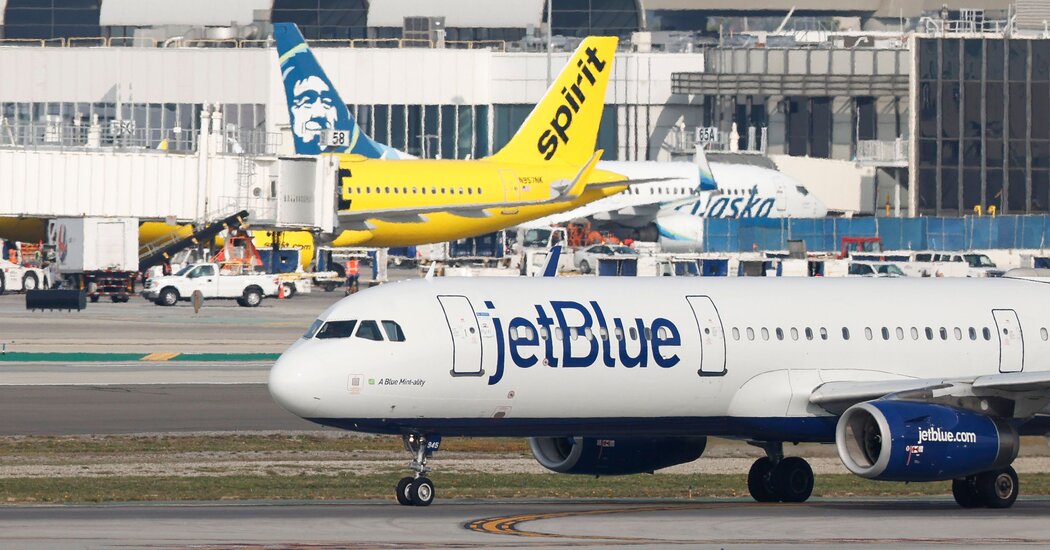Planes line the runway at LaGuardia Airport on November 10, 2025 in New York City.
Spencer Platt | Getty Images News | fake images
The United States has been struggling for years to hire more air traffic controllers. The longer federal government shutdown could have made it even more difficult.
“We need more of them to join the profession, and this shutdown will make it harder for us to achieve that goal,” Transportation Secretary Sean Duffy said Tuesday at a news conference at Chicago's O'Hare International Airport, a day before Congress signed a bill to fund the federal government through January, ending the shutdown.
Air traffic controllers had to work without receiving regular salaries during the shutdown. They were paid in part on Friday, according to people familiar with the matter, but during the shutdown some had taken second jobs to make ends meet, while the lack of a regular salary added to their stress, union and government officials and lawmakers said.
The Federal Aviation Administration reported that low staffing thresholds were reached that slowed planes across the country during the final days of the shutdown. President Donald Trump threatened earlier this week to cut air traffic controllers' pay if they didn't come to work. On Friday, staffing levels were relatively high in the United States and disruptions decreased.
“You can't make it seem like it's a big job because you're going to have to deal with this all the time,” said Tim Kiefer, a professor of air traffic management at Embry-Riddle Aeronautical University in Prescott, Arizona.
Kiefer was an air traffic controller for more than two decades before retiring. He said closures or the threat of them were common during his career. “You can see people decide to do other things and say, 'They didn't get paid; they were stuck in the middle of a partisan dispute,'” he said.
5 million passengers
A shortage of air traffic controllers delayed or canceled thousands of flights during the shutdown, affecting the travel plans of more than 5 million people, according to Airlines for America, an industry group that includes american airlines, united airlines, Delta Airlines, Southwest Airlines and others.
But even if partial salaries hit bank accounts, the staffing crisis that typically plagues travel will continue.
A government count last year showed the United States was missing 3,903 fully certified air traffic controllers out of a goal of 14,633. The shortage has been particularly acute at busy facilities such as those where controllers guide planes in and out of airports in the congested New York area, increasing flight disruptions and frustrating airline executives and customers.
Meanwhile, retirements increased during the shutdown, with between 15 and 20 people retiring a day, compared to the usual rate of four a day, Duffy said Tuesday. Controllers must retire at age 56, but can do so sooner with benefits that depend on years of work.
Staffing was already tight before the shutdown began on Oct. 1, with many controllers working six-day workweeks. In mid-November, when air traffic controllers lost two full paychecks and the shutdown surpassed the one-month mark, it approached crisis levels.
More than 10% of departures from the United States were canceled last Sunday due to bad weather combined with a shortage of air traffic controllers at facilities across the country. That was the highest rate since July 19, 2024, during the Strike crowd blackout, which had a huge impact on Delta Airlinesleading to thousands of canceled flights and travel headaches, according to aviation data firm Cirium.
Hours after those cancellations increased on Sunday, the Senate advanced a preliminary agreement that led to the vote that ended the shutdown this week.
In early November, the Federal Aviation Administration ordered airlines to cut 4% of flights from their domestic schedules at 40 major airports, blaming safety risks they encountered due to increased pressure on air traffic controllers. The cuts were expected to rise to 10% on Friday if the shutdown did not end. However, cancellations improved dramatically during the week and only 2% of US departures were canceled as of Friday morning, according to Cirium.
The FAA reduced its mandatory cuts from 6% to 3% starting Saturday, saying it will monitor the system's performance throughout the weekend.
Outages were similar to days with severe storms, but were more widespread across the US.
Millions in lost revenue
The last-minute cuts were a headache for the industry, where airlines from cash-strapped Delta to struggling airline Spirt had already lowered their outlook for the year after an oversupply of flights and weaker-than-expected demand earlier this year. Airlines have not yet quantified the damage from the shutdown, but Bank of America estimated an impact on operating income of between $150 million and $200 million for large airlines and less than $100 million for other airlines.
Travelers walk through the terminal at Ronald Reagan Washington National Airport, more than a month into the current US government shutdown, in Arlington, Virginia, US, on November 11, 2025.
Annabelle Gordon | Reuters
Airline executives, exasperated by the recent disruptions, are now pressing Congress to ensure that controllers get paid in the next shutdown.
“Over the past week, we have seen a crescendo effect as air traffic control staffing shortages have caused massive and unpredictable numbers of delays and cancellations across the industry, and that has come on top of a series of schedule reductions ordered by the FAA,” American Airlines CEO Robert Isom and the airline's chief operating officer, David Seymour, said in a note to employees Thursday, a day after the House passed a short-term funding bill. “While we have both been in this industry for a long time, only a few other events come to mind when we think about this level of disruption.”
It could have been worse. This portion of fall travel demand is relatively light, but Thanksgiving was quickly approaching as Congress ended the shutdown, which was impacting airline executives.
“This shutdown put enormous strain on our aviation system and caused serious inconvenience to the millions of Americans who depend on it,” United said in a statement. “It should be obvious to everyone that political debates, no matter how urgent, should never put air travel at risk, and we urge Congress to ensure that the FAA and [Transportation Security Administration’s] Funding is protected in the event of any future lapse in federal appropriations.”
'Political football'
It is not the first time that a government shutdown has put the aviation industry under pressure. The 2018-2019 shutdown, then the longest in U.S. history, ended just hours after a driver shortage hit travel in the New York City area.
Some airline executives told CNBC they were frustrated by this most recent shutdown and last-minute schedule changes, which ended up being larger than anticipated. One, who spoke on condition of anonymity because he was not authorized to speak to the press, said “we were the pawns” of the closure.

Delta CEO Ed Bastian said Wednesday on CNBC's “Squawk on the Street” that “what we don't like is being a political football” and said it was unacceptable that air traffic controllers and TSA agents were forced to work without regular pay.
The best way to prevent such disruptions is to “ensure that those workers, the next time this happens, because it will happen, get paid,” Bastian said. “Who could disagree with that?”
The airline industry is urging Congress to pass legislation that could use funds generated by airline ticket taxes to ensure that air traffic controllers and other essential industry workers, such as airport inspectors and customs agents, are paid.
“You can't hold the American public hostage in a political fight like that,” Airlines for America CEO Chris Sununu, the former governor of New Hampshire, said in a virtual news conference on Wednesday, shortly before the House passed the funding bill.
Travelers check their flight status at Dulles International Airport as the country's air travel system begins to return to normal, as the US government reopens after the longest shutdown in US history, in Dulles, Virginia, US, on November 13, 2025.
Evelyn Hockstein | Reuters
Next Wednesday, Sen. Jerry Moran, R-Kan., who chairs the Commerce Subcommittee on Aviation, Space and Innovation, will hold a hearing on the impact of the shutdown on aviation. Moran pushed this year for legislation that would allow the FAA to use the Airports and Airways Trust Fund, which is funded by taxes on airline tickets and fuel, to cover expenses if the government shuts down.
“The government shutdown has severely impacted our already fragile aviation industry, and recovering from its effects will take time,” he said in a statement this week. “It is essential that we address the damage caused and analyze the long-term effects of the closure.”
Earlier this year, lawmakers approved $12.5 billion to improve air traffic control, although the industry said it needs billions more to modernize the system in the United States.
The fatal collision of an American Airlines regional jet and an Army Black Hawk helicopter in Washington, D.C., in January also made the hiring of controllers more urgent, especially at congested facilities.
About a month after the crash, Duffy announced that the country's air traffic controller academy would raise student salaries and authorized more universities to teach a similar curriculum to help alleviate the shortage. The academy in Oklahoma City also remained open, a different tactic than the 2018-2019 shutdown.
But those are not immediate solutions. It takes years for controllers to be fully trained to work in some of the most complex facilities, and academy applicants can be no older than 30.










